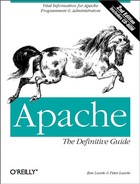9.1. Proxy Directives
We are not concerned here with firewalls, so we take them for granted. The interesting thing is how we configure the proxy Apache to make life with a firewall tolerable to those behind it.
site.proxy has three subdirectories: cache, proxy, real. The Config file from ... /site. proxy/proxy is as follows:
User webuser Group webgroup ServerName www.butterthlies.com Port 8000 ProxyRequests on CacheRoot /usr/www/site.proxy/cache CacheSize 100000
The points to notice are that:
On this site we use ServerName www.butterthlies.com.
The Port number is set to 8000 so that we can change proxies without having to change users' Configs.
We turn ProxyRequests on and provide a directory for the cache, which we will discuss later in this chapter.
CacheRoot is set up in a special directory.
CacheSize is set to 100000 kilobytes.
9.1.1. ProxyRequests
ProxyRequests [on|off] Default: off Server config
This directive turns proxy serving on. Even if ProxyRequests is off, ProxyPass directives are still honored.
9.1.2. ProxyRemote
ProxyRemote remote-server = protocol://hostname[:port] Server config
This directive defines remote proxies to this proxy. remote-server is either the name of a URL scheme that the remote server supports, a partial URL for which the remote server should be used, or " * " to indicate that the server should be contacted for all requests. protocol is the protocol that should be used to communicate with the remote server. Currently, only HTTP is supported by this module. For example:
ProxyRemote ftp http://ftpproxy.mydomain.com:8080 ProxyRemote http://goodguys.com/ http://mirrorguys.com:8000 ProxyRemote * http://cleversite.com
9.1.3. ProxyPass
ProxyPass path
url
Server configThis command runs on an ordinary server and translates requests for a named directory and below to a demand to a proxy server. So, on our ordinary Butterthlies site, we might want to pass requests to /secrets onto a proxy server darkstar.com:
ProxyPass /secrets http://darkstar.com
Unfortunately, this is less useful than it might appear, since the proxy does not modify the HTML returned by darkstar.com. This means that URLs embedded in the HTML will refer to documents on the main server unless they have been written carefully. For example, suppose a document one.html is stored on darkstar.com with the URL http://darkstar.com/one.html, and we want it to refer to another document in the same directory. Then the following links will work, when accessed as http://www.butterthlies.com/secrets/one.html:
<A HREF="two.html">Two</A> <A HREF="/secrets/two.html">Two</A> <A HREF="http://darkstar.com/two.html">Two</A>
But this example will not work:
<A HREF="/two.html">Not two</A>
When accessed directly, through http://darkstar.com/one.html, these links work:
<A HREF="two.html">Two</A> <A HREF="/two.html">Two</A> <A HREF="http://darkstar.com/two.html">Two</A>
But the following doesn't:
<A HREF="/secrets/two.html">Two</A>
9.1.4. ProxyDomain
ProxyDomain Domain Server config
This directive is only useful for Apache proxy servers within intranets. The ProxyDomain directive specifies the default domain to which the Apache proxy server will belong. If a request to a host without a domain name is encountered, a redirection response to the same host with the configured Domain appended will be generated.
9.1.5. NoProxy
NoProxy { Domain | SubNet | IpAddr | Hostname }
Server configThis directive is only useful for Apache proxy servers within intranets. The NoProxy directive specifies a list of subnets, IP addresses, hosts, and/or domains, separated by spaces. A request to a host that matches one or more of these is always served directly, without forwarding to the configured ProxyRemote proxy server(s).
9.1.6. ProxyPassReverse
ProxyPassReverse path url Server config, virtual host
A reverse proxy is a way to share load between several servers—the frontend server simply accepts requests and forwards them to one of several backend servers. The optional module mod_rewrite has some special stuff in it to support this. This directive lets Apache adjust the URL in the Location response header. If a ProxyPass (or mod_rewrite) has been used to do reverse proxying, then this directive will rewrite Location headers coming back from the reverse proxied server so that they look as if they came from somewhere else (normally this server, of course).
